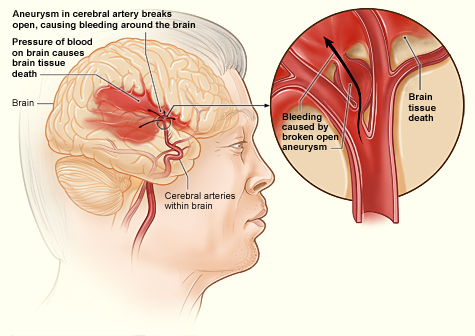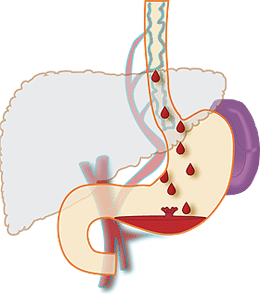Internal Bleeding
Published (updated: ).

Imagine a patient is bleeding to death, but there is no blood to be seen
Internal bleeding is bleeding that occurs within the body. An injury that damages the outside of the body is easy to see. A cut or tear in the skin usually bleeds. One can see what’s hurt, and it’s easy to pinpoint what caused it.
Internal bleeding isn’t as easy to see or diagnose. Bleeding internally is often the result of trauma or an injury. Less obvious causes can result in internal bleeding, too. These include gastritis, organ damage, or a bleeding disorder.
In some cases, the bleeding may be a sign of a life-threatening condition. If someone suddenly develops the following symptoms, seek immediate medical attention. These could be symptoms of internal bleeding:
- dizziness
- severe weakness
- passing out
- low blood pressure
- acute visual problems
- numbness
- weakness on one side of the body
- severe headache
- severe abdominal pain
- shortness of breath
- chest pain
- nausea
- vomiting
- diarrhea
The medics may notice bloody or dark vomit or stool. Occasionally, if the bleeding is behind the internal organs in the abdomen, they may be bruising around the navel or on the sides of the abdomen (flanks).
Signs and symptoms of internal bleeding
Internal bleeding is a symptom of an injury, condition, or disease. Recognizing the symptoms of internal bleeding can help the emergency crew understand what’s bleeding, why it’s bleeding, and what conditions could be contributing to the problem.

Internal bleeding in the head
This can cause:
- weakness, usually on one side of the body
- numbness, usually on one side of the body
- tingling, especially in hands and feet
- severe, sudden headache
- difficulty swallowing or chewing
- change in vision or hearing
- loss of balance, coordination, and eye focus
- difficulty speaking or understanding speech
- difficulty writing
- changes in overall alertness, including increases in sleepiness, lethargy, or stupor
- loss of consciousness
Internal bleeding in the chest or abdomen
This can cause:
- abdominal pain
- shortness of breath
- chest pain
- dizziness, especially when standing
- bruising around the naval or on the sides of the abdomen
- nausea
- vomiting
- blood in urine
- black, tarry stool
- bleeding from another area, including ears, nose, mouth, or anus
Internal bleeding into the muscles or joints
This can cause:
- pain in a joint
- swelling in a joint
- decreased range of motion
Other symptoms
It’s possible to experience shock in some cases of internal bleeding.
This is especially true if internal bleeding occurs in locations where a substantial amount of blood can be lost, such as the chest, abdomen, or thigh. Shock occurs when there’s not enough blood to supply the whole body.
Symptoms of shock include:
- rapid heart rate
- low blood pressure
- sweaty skin
- changes in overall alertness, including increases in sleepiness, lethargy, or stupor
- overall weakness
The presence of other underlying conditions may help doctors identify if the patient losing blood somewhere.
For example, anemia is commonly associated with a slow and chronic internal bleeding. It can cause fatigue, weakness, and shortness of breath.
Some people with internal bleeding will also have low blood pressure because of the constant blood loss. This is known as orthostatic hypotension. Common symptoms include feeling dizzy or light-headed when the patient stands.

Causes of internal bleeding
Sometimes, identifying what’s causing internal bleeding can be simple. If the patient has been involved in an accident or had a recent injury, the bleeding is likely the result of that event. Also, diagnosing the cause may be easier if the patient has a condition that can lead to internal bleeding, such as gastritis. However, not every case of internal bleeding is so clear-cut. Finding the source of internal bleeding may take some time and require a thorough physical examination.
General causes
These can include:
- Damage to a blood vessel. Minor tears can occur with an injury.
- Clotting factors. The body makes proteins to stop any bleeding in the event that the patient is cut or injured. If the body doesn’t make enough clotting factors, it may bleed freely.
- Certain medications. Certain medications, like blood thinners, can prevent clotting and lead to severe bleeding if the patient is injured or has been an accident. Some over-the-counter medications, including aspirin, can damage the lining of the stomach.
- Chronic high blood pressure. High blood pressure weakens blood vessel walls. Weak walls can form aneurysms that can rupture and bleed.
- Inherited bleeding disorders. Hemophilia is a genetic condition that prevents blood from properly clotting. A minor injury may bleed heavily if it’s not properly treated.
- Gastrointestinal (GI) causes. Bleeding into the abdomen, or stomach, may be caused by one of several GI conditions. These include colon polyps, colitis, Crohn’s disease, gastritis, esophagitis, and peptic ulcers.
- Endometriosis. Endometriosis is a condition where endometrium-like tissue grows outside the uterus in areas like the ovaries, abdomen, and bowel. The uterus will shed its lining and cause bleeding in a separate place, such as the pelvis. Diagnosis is made with the help of biopsies, a CT scan, an MRI, and an ultrasound.
- Lifestyle factors. Alcohol, smoking, and illicit drugs can irritate the lining of the stomach.
More serious causes
These can include:
- Trauma. Experiences including car accidents, falls, and dropping a heavy object on oneself can damage organs, blood vessels, and bones. The patient could experience internal bleeding without even cutting the skin.
- Aneurysms. Weak blood vessel walls can bulge and form pockets of blood. Many aneurysms don’t cause any symptoms, but a burst aneurysm can be life-threatening.
- Broken bones. Most broken bones are nothing to be worried about, but breaking the body’s larger bones, such as the femur, can cause significant internal bleeding.
- Ectopic pregnancy. A pregnancy outside the uterus can cause internal bleeding as the fetus grows. The condition can be life-threatening.
- Surgery. Before a surgeon completes an operation, they make sure all the bleeding has stopped. If they miss something, bleeding may continue even after the incision is closed. In some cases, this bleeding can be severe.
Diagnosing internal bleeding
Diagnosing an internal bleed usually requires medical tests, a physical exam, and a thorough review of medical history. The doctor may use lab tests and imaging tools to both identify the cause of internal bleeding and measure the severity.
For injuries, an imaging test may be all that’s necessary. An X-ray shows an image of bones. A CT scan is an advanced X-ray that can see bones, tissues, and blood vessels. Angiography is an imaging test that can carefully examine individual blood vessels.
